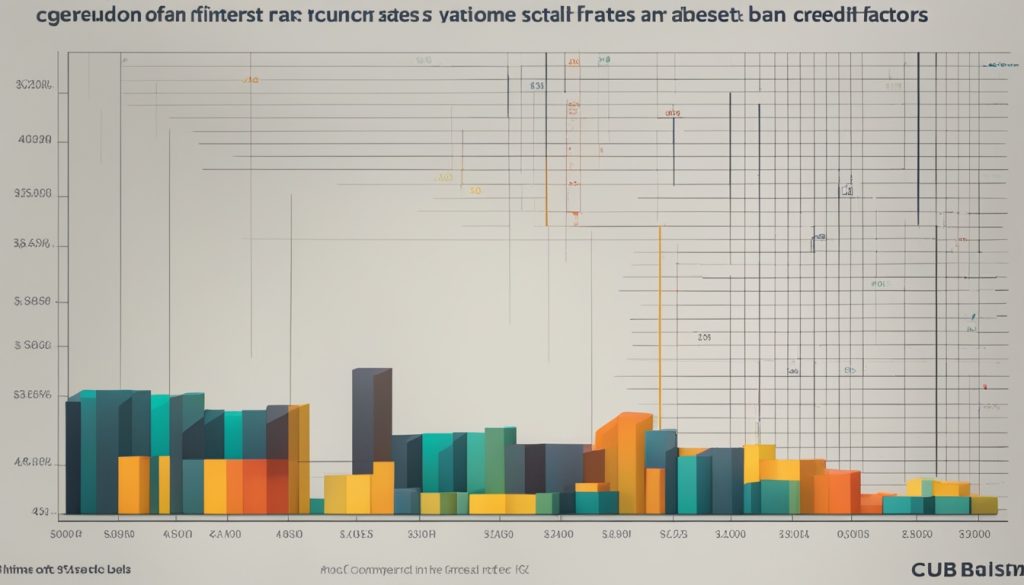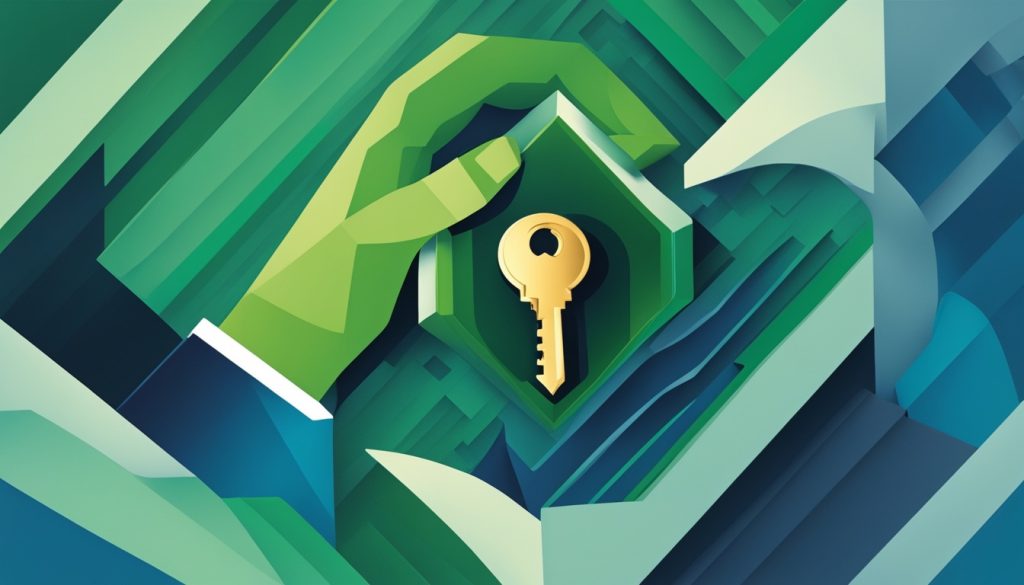Getting a low-interest loan can really help you manage your money better and cut down on costs. To get one, you need to show you’re good with money and stable financially. This means having a great credit score, a low debt-to-income ratio, steady income, and maybe some collateral or a down payment1.
Knowing what affects your loan’s interest rate and how to lower your costs is key. This knowledge helps you make smart choices and feel sure about applying for a loan. By looking into different lenders, prequalifying, and checking out places like credit unions, you can get a low-interest loan that fits your budget2.
Key Takeaways
- Excellent credit score (minimum 670, with 720 for more favorable terms)1
- Low debt-to-income ratio (ideally below 36%, with up to 50% for highly qualified applicants)1
- Consistent and steady monthly income, with proof of income such as pay stubs, W-2s, and tax returns1
- Potential collateral or down payment to improve loan terms1
- Researching lender options, prequalifying, and considering credit unions can increase your chances of securing a low-interest loan2
Understanding Low-Interest Personal Loans
A low-interest personal loan has an APR below the national average3. The average rate for personal loans is 12.35 percent as of July 103. People with credit scores over 740 can get the lowest rates3. Lenders also look at your debt-to-income ratio, aiming for ratios under 36 percent3.
What Is a Low Interest Rate for a Personal Loan?
Low-interest personal loans are those with rates below the national average3. Those with excellent credit can get rates from 10.73 percent to 12.5 percent3. For average credit scores, rates range from 17.8 percent to 19.9 percent3.
Average Personal Loan Interest Rates
The average personal loan rate is 12.35 percent as of July 10, 20244. Top lenders like Upstart and LightStream offer rates under 8 percent for qualified borrowers4. Even with good credit, rates can be over 10 percent due to market changes4. It’s rare to find rates under 7 percent4. Credit unions offer loans with rates up to 18 percent, much lower than other lenders’ 36 percent cap4. Shorter repayment periods, under 48 months, can lead to better rates4.
Factors That Impact Your Personal Loan Rate
Getting a personal loan means looking at the interest rate closely. This rate can change how much you pay back. Lenders look at your credit score, debt-to-income ratio, employment status, income, loan amount, and loan term to set your rate. Rates can also be affected by the Secured Overnight Financing Rate (SOFR)5.
People with better credit scores and lower debt-to-income ratios often get lower rates. They also need stable employment and higher incomes5. The average interest rate for personal loans is about 25.06%5. But, rates can go from 12.90% to 31.12%5.
By credit tier, rates in May 2024 were 21.23% for excellent credit, and higher for others5. In June 2024, rates went down a bit5. Lenders offer APRs from 5.91% to 34.00%, with a top of 295.00%5.
| Credit Tier | Average APR |
|---|---|
| Excellent Credit | 21.23% |
| Good Credit | 26.01% |
| Fair Credit | 30.91% |
| Poor Credit | 30.94% |
Things like your creditworthiness and income affect loan rates5. So does the loan’s length and how much money is available5. Rates can also change with the federal funds rate set by the Federal Reserve5.

Knowing what affects personal loan rates can help you make better choices. By improving your finances, you might get a lower rate67.
The Importance of low-interest loan, loan qualification, borrowing costs
Personal financing can be affected a lot by the interest rate on your loan. Low-interest personal loans can change the game, helping you pay less over the loan’s life8.
Pros and Cons of Low-Interest Personal Loans
Low-interest personal loans can save you thousands in interest charges8. This means you can use that money for other important goals, like paying off high-interest debts or saving more. They also make your monthly payments lower, making budgeting easier.
But, low-interest loans have downsides too. They might be harder to get because of stricter rules9. And if you can’t pay them back, the legal trouble is as bad as with any other loan. So, make sure you can afford the monthly payments.

Choosing a low-interest personal loan depends on your financial situation and goals. Think about the good and bad sides to see if it fits your needs and helps you reach your financial goals89.
Where to Find Low-Interest Personal Loans
Looking for a low-interest personal loan? Check out credit unions and online lenders10. They usually have the best rates, with some as low as 6.99% for top applicants10. The average rate was about 11% in Q2 202310.
To get the lowest rate, get pre-approved with several lenders and compare their offers10. This helps you find the best deal based on your credit score, debt, job, and income1011.
Don’t forget to look at the lender’s reputation, customer service, and how easy it is to apply10. A smooth, clear process can greatly improve your experience.
- Credit unions
- Online lenders
- Comparing multiple pre-approved offers
By doing your homework and exploring these options, you can find a low-interest loan. This way, you can make the most of your borrowing experience1011.
Building Your Qualifications
How to Qualify for a Low-Interest Personal Loan
To get a low-interest personal loan, focus on making your credit look good. This means having a high credit score, a low debt-to-income ratio, and a steady income. Using collateral can also help12.
Lenders want a credit score of 640 or more for the best rates and terms12. If you can get your score up to 670 or higher, you’re more likely to get a loan with low interest12.
Your debt-to-income ratio should be 35% or less for good loan rates12. Paying off debts and earning more can lower this ratio. This makes it easier to get a loan with low interest.
Adding collateral like a car or home equity can also help. It makes lenders feel safer, which means better loan terms for you12.
Working on your creditworthiness can boost your chances of getting a low-interest loan12. Look at different lenders, compare their rates and fees, and pick the best loan for your needs.
Strategies to Secure a Low-Interest Loan
Getting a low-interest personal loan can save you a lot of money over time. To get the best rate, use a few key strategies13.
- Prequalify with Multiple Lenders: Prequalify with several lenders to compare offers. This way, you can find the lowest rate without hurting your credit score13.
- Take Advantage of Autopay Discounts: Many lenders give you a small rate drop, 0.25-0.50%, for automatic payments. This easy step can save you money13.
- Consider Credit Unions: Credit unions often have lower rates on personal loans than banks. They are member-owned, so they might offer better deals to their members13.
- Borrow Only What You Need: Don’t borrow more than you need. Borrowing less can help you get a lower rate13.
Using these strategies can help you get a low-interest personal loan that fits your budget and goals13.
| Lender | Loan Amount | Repayment Term | Interest Rate |
|---|---|---|---|
| Happy Money | Specific purposes, such as credit card debt consolidation13 | N/A | N/A |
| LightStream | Up to $100,000, typically for large purchases or home improvement projects13 | Up to 12 years for home improvement, up to 7 years for other purposes13 | N/A |
Remember, personal loan rates can vary a lot, with the average rate over 12 percent13. By comparing offers, knowing your credit score, and borrowing wisely, you can get a low-interest loan that meets your financial goals13.
“The average credit card interest rate is around 21 percent, making personal loans with rates averaging 12 percent a more attractive option for debt consolidation.”13
By using these strategies, you can increase your chances of getting a low-interest personal loan that fits your budget and helps you reach your financial goals13.
Conclusion
Getting a low-interest loan can save you money and make your finances easier to manage14. Knowing what affects your loan rate, like your credit score and income, helps you improve your chances of getting a good rate15.
Looking at different lenders and using smart strategies, like choosing a shorter loan term, can also help you get a low-interest loan1514. With careful research and planning, you can find the right loan for your financial needs and goals14.
Understanding what affects your borrowing costs and using smart tactics can lead to a low-interest loan1514. This can improve your financial health over time. It makes reaching your financial goals easier and more achievable1514.
FAQ
What factors do lenders consider when determining my personal loan interest rate?
Lenders look at many things to set your loan’s interest rate. This includes your credit score, debt-to-income ratio, job status, income, loan size, loan length, and benchmark rates like the Secured Overnight Financing Rate (SOFR). If you have a high credit score, low DTI, steady job, and good income, you’ll likely get the best rates.
What is considered a low interest rate for a personal loan?
A low-interest personal loan has an APR under the national average, about 11%. If you have an excellent credit score (FICO 800+) and a low debt-to-income ratio, you might get rates as low as 6.99%. But, rates can go from 6.59% for super-prime borrowers to over 15% for those with poor credit.
What are the pros and cons of a low-interest personal loan?
Low-interest loans can cut down the total cost of borrowing by reducing interest over the loan’s life. They’re great for those needing financing but wanting to keep costs low. But, they also have downsides, like less monthly budget flexibility and the risk of legal trouble if you default.
Where can I find the lowest interest rates on personal loans?
Credit unions and online lenders often have the lowest interest rates on personal loans. Getting pre-approved with several lenders helps you compare offers and find the best rate. When looking for a low-interest loan, think about rates, fees, customer service, and the lender’s reputation.
How can I qualify for a low-interest personal loan?
To get a low-interest personal loan, work on improving your creditworthiness. This means having a great credit score, a low debt-to-income ratio, and a steady income. Paying off high-interest debt and enhancing your credit history can also help you get the lowest rates.
Source Links
- 5 Personal Loan Requirements To Know Before Applying
- What Are the Requirements for a Personal Loan? – NerdWallet
- How to Qualify for Low-Interest Personal Loans | Bankrate
- What A Low-Interest Personal Loan Is & Where To Get One | Bankrate
- What Is the Average Personal Loan Interest Rate?
- Average Personal Loan Interest Rates In 2024 | Bankrate
- Average Personal Loan Interest Rates
- Interest Rates: Different Types and What They Mean to Borrowers
- How Low Interest Rates Can Impact Your Finances
- Best Low-Interest Personal Loans Of July 2024
- Personal Loan Rates: Compare Top Lenders in July 2024 – NerdWallet
- Personal Loan Requirements & How to Meet Them | LendingTree
- Does Your Loan Purpose Matter? Yes — Here’s Why | Bankrate
- How Interest Rates Affect Debt | Bankrate
- How Reduced Interest Rates Affect Mortgage Costs – Experian

